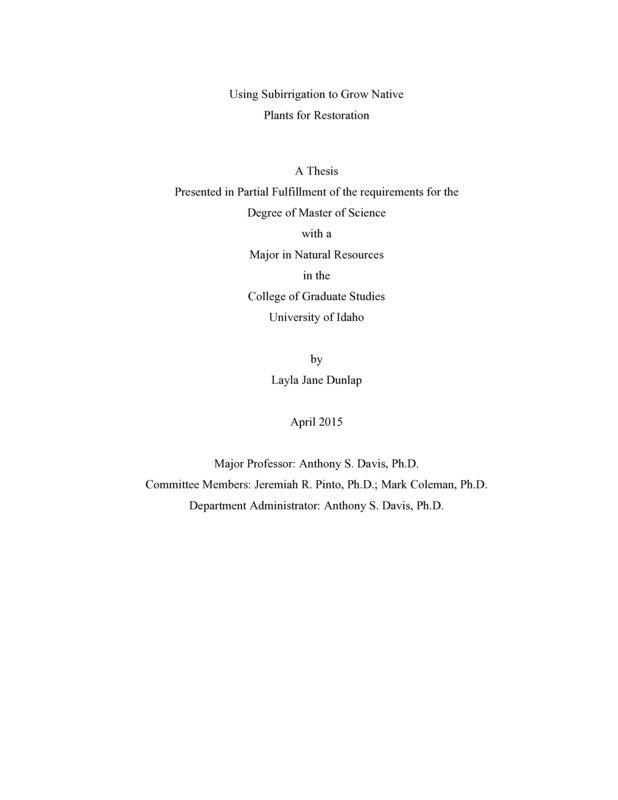Using Subirrigation to Grow Native Plants for Restoration
Dunlap, Layla. (2015). Using Subirrigation to Grow Native Plants for Restoration. Theses and Dissertations Collection, University of Idaho Library Digital Collections. https://www.lib.uidaho.edu/digital/etd/items/dunlap_idaho_0089n_10626.html
- Title:
- Using Subirrigation to Grow Native Plants for Restoration
- Author:
- Dunlap, Layla
- Date:
- 2015
- Embargo Remove Date:
- 2016-05-12
- Keywords:
- fertilizer restoration subirrigation
- Program:
- Natural Resources
- Subject Category:
- Forestry; Horticulture
- Abstract:
-
Subirrigation (SI) watering systems are gaining recognition in native plant nurseries as water conservation measures and wastewater runoff issues gain attention. In 2013, we investigated the characteristics of four different types of fertilizer using a subirrigation regime for 18 weeks; our study species was red-flowering currant (Ribes sanguineum). Treatments included: organic fertilizer (OF), incorporated; controlled-release fertilizer, incorporated (MF) or top-dressed (TF); and water-soluble fertilizer (SF). Results revealed seedlings potted with OF used significantly less water than all other treatments. Media electrical conductivity (EC) levels were significantly higher in the OF treatment, and EC values in the top portion of the media were significantly higher than the middle or bottom portions for all fertilizer treatments. The remaining SI water at the end of 22 weeks held 17% of applied nitrogen from the water-soluble fertilizer and less than 1% of applied nitrogen from the other fertilizer treatments. There were no differences in plant morphological characteristics and similar quality plants were produced among all fertilizer treatments under a SI system. Seedlings were outplanted in May 2014 under two vegetative competition types. Ten plots were selected; landscape fabric was used to create 5 plots with low competition (LC), and existing vegetation was contained in 5 plots to create high competition (HC). We examined the effects of fertilizer type and competition on seedling morphological and physiological characteristics in the field. There were no residual effects from the fertilizer types used during nursery cultivation. Growth and net photosynthesis rates were significantly higher in LC plots compared to HC plots. Significant differences occurred between competition types in predawn and midday water potentials over the growing season. Volumetric soil water content was significantly higher in the LC plots in the upper soil profile (10 cm) June - September, while significant differences at the 40 cm soil depth occurred during August only. Vegetative competition for soil water limited seedling success. We conclude that a variety of fertilizers can be used to grow red-flowering currant under SI; although, some fertilizers may require more management care than others. Furthermore, red-flowering currant seedlings establish more readily on sites without competing vegetation.
- Description:
- masters, M.S., Natural Resources -- University of Idaho - College of Graduate Studies, 2015
- Major Professor:
- Davis, Anthony S
- Committee:
- Pinto, Jeremiah R; Coleman, Mark
- Defense Date:
- 2015
- Identifier:
- Dunlap_idaho_0089N_10626
- Type:
- Text
- Format Original:
- Format:
- application/pdf
- Rights:
- In Copyright - Educational Use Permitted. For more information, please contact University of Idaho Library Special Collections and Archives Department at libspec@uidaho.edu.
- Standardized Rights:
- http://rightsstatements.org/vocab/InC-EDU/1.0/

